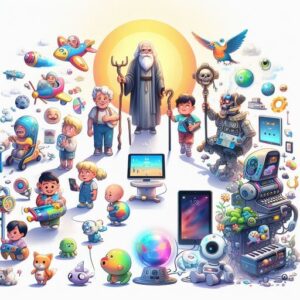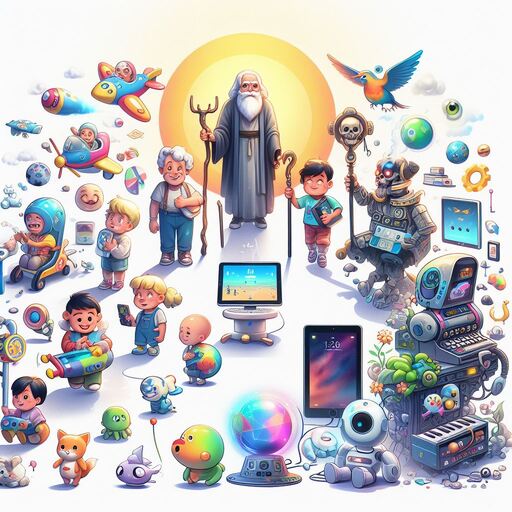Children’s tablets have undergone a remarkable evolution since their inception, transforming from simple devices for entertainment to powerful tools for learning and development. As technology advances and educational needs evolve, children’s tablets continue to adapt to meet the demands of modern learners. In this article, we will explore the journey of children’s tablets, examining their past milestones, current innovations, and future trends shaping the landscape of educational technology.

The Emergence of Children’s Tablets
The concept of children’s tablets first gained traction in the early 2010s with the introduction of dedicated devices designed specifically for young users. These early tablets, such as the LeapPad Explorer and VTech InnoTab, featured kid-friendly interfaces, educational content, and parental controls to cater to the unique needs of children. Their primary focus was on providing entertainment and basic educational activities, such as interactive games, e-books, and videos, aimed at early childhood development.
Shift Towards Educational Focus
As awareness grew regarding the potential of technology to enhance learning outcomes, children’s tablets began to evolve beyond mere entertainment devices. Educational content developers and tech companies started incorporating curriculum-aligned materials, adaptive learning features, and assessment tools into children’s tablets to support academic skills and promote cognitive development. Tablets like the Amazon Fire Kids Edition and Samsung Galaxy Tab Kids emerged as popular choices for parents seeking educational content and parental controls.
Integration of Interactive Learning Apps
With the proliferation of app stores and the rise of mobile learning apps, children’s tablets expanded their educational offerings to include a wide range of interactive learning apps covering various subjects and skills. These apps leverage gamification, multimedia content, and adaptive technology to engage children in meaningful learning experiences. Educational apps like ABCmouse, Khan Academy Kids, and PBS Kids Play & Learn have become staples on children’s tablets, providing access to interactive lessons, activities, and games aligned with academic standards.
See price for Fire HD 10 Kids Tablet (32GB, Disney Mickey Mouse) + Kids Headset https://amzn.to/4asMT1Q
Incorporation of STEAM Education
Recognizing the importance of STEAM (Science, Technology, Engineering, Arts, and Mathematics) education in preparing students for the future, children’s tablets have increasingly focused on integrating STEAM-related content and activities into their platforms. Tablets equipped with coding apps, robotics kits, and creative tools empower children to explore STEM concepts, develop problem-solving skills, and engage in hands-on learning experiences. Products like the Kano Computer Kit and Osmo Genius Starter Kit exemplify this trend by offering innovative STEAM learning solutions for children.
Personalization and Adaptive Learning
As educators and parents seek to address individual learning needs and preferences, children’s tablets have embraced personalization and adaptive learning technologies. These technologies utilize data analytics, artificial intelligence, and machine learning algorithms to tailor learning experiences to each child’s abilities, interests, and learning styles. Tablets equipped with adaptive learning platforms, such as DreamBox Learning and Smartick, adapt content and pacing based on student performance, providing targeted instruction and personalized feedback.
Integration of Augmented Reality (AR) and Virtual Reality (VR)
The integration of augmented reality (AR) and virtual reality (VR) technologies into children’s tablets has opened up new possibilities for immersive learning experiences. AR and VR apps allow children to explore virtual environments, interact with 3D objects, and engage in simulations that bring learning to life. Tablets like the Apple iPad Pro and Lenovo Tab P11 Pro support ARKit and Google ARCore platforms, enabling developers to create educational AR and VR content for children.
See price for Contixo 10″ Android Kids Tablet 64GB Bundle, Includes 80+ Disney Storybooks & Stickers (Value $350), Kid-Proof Case with Kickstand & Stylus, Headphone, Sleeve Bag (2023 Model) (Blue) https://amzn.to/3TxWfm8
Focus on Digital Citizenship and Online Safety
With the increasing prevalence of digital devices and online connectivity, children’s tablets have placed greater emphasis on promoting digital citizenship and online safety. Parental control features, content filtering tools, and educational resources on digital literacy and internet safety help parents and educators guide children’s online behavior and teach responsible use of technology. Tablets like the Google Pixel Slate and Microsoft Surface Go prioritize security and privacy features to protect children from online threats and inappropriate content.
Future Trends in Children’s Tablets
Looking ahead, several trends are poised to shape the future of children’s tablets:
-
- Artificial Intelligence (AI) Integration: AI-powered virtual assistants and adaptive learning algorithms will play a more prominent role in children’s tablets, providing personalized learning experiences and intelligent tutoring systems.
- Enhanced Collaboration Tools: Children’s tablets will incorporate more collaborative features, such as multiplayer games, shared workspaces, and video conferencing tools, to facilitate collaborative learning and social interaction.
- Expanded Access to Global Resources: Children’s tablets will offer greater access to global learning resources, cultural experiences, and language-learning opportunities, enabling children to connect with peers worldwide and explore diverse perspectives.
- Innovation in Physical Design: Future children’s tablets may feature innovative designs, materials, and form factors optimized for durability, portability, and ease of use in diverse learning environments.
- Integration with Emerging Technologies: Children’s tablets will continue to integrate emerging technologies, such as artificial intelligence, augmented reality, and wearable devices, to deliver immersive and interactive learning experiences.
See price for Fire HD 10 Kids Tablet (32GB, Sky Blue) + Kids Stylus https://amzn.to/497An78
Conclusion
The evolution of children’s tablets reflects the ongoing efforts to harness the power of technology for educational purposes and meet the evolving needs of young learners. From their humble beginnings as entertainment devices to their current status as powerful educational tools, children’s tablets have come a long way in revolutionizing learning and fostering creativity, imagination, and skill development. As technology continues to advance, children’s tablets will play an increasingly vital role in shaping the future of education, empowering students to thrive in a digital world characterized by innovation, collaboration, and lifelong learning.

